# 字符串常見操作
如有字符串`mystr = 'hello world itcast and itcastcpp'`,以下是常見的操作
#### 1\. find
檢測 str 是否包含在 mystr中,如果是返回開始的索引值,否則返回-1
~~~
mystr.find(str, start=0, end=len(mystr))
~~~


#### 2\. index
跟find()方法一樣,只不過如果str不在 mystr中會報一個異常.
~~~
mystr.index(str, start=0, end=len(mystr))
~~~

#### 3\. count
返回 str在start和end之間 在 mystr里面出現的次數
~~~
mystr.count(str, start=0, end=len(mystr))
~~~

#### 4\. replace
把 mystr 中的 str1 替換成 str2,如果 count 指定,則替換不超過 count 次.
~~~
mystr.replace(str1, str2, mystr.count(str1))
~~~
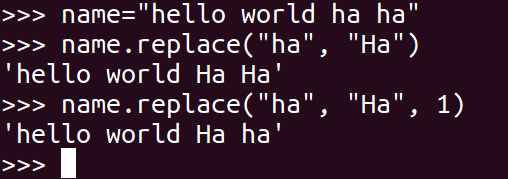
#### 5\. split
以 str 為分隔符切片 mystr,如果 maxsplit有指定值,則僅分隔 maxsplit 個子字符串
~~~
mystr.split(str=" ", 2)
~~~

#### 6\. capitalize
把字符串的第一個字符大寫
~~~
mystr.capitalize()
~~~

#### 7\. title
把字符串的每個單詞首字母大寫
~~~
>>> a = "hello itcast"
>>> a.title()
'Hello Itcast'
~~~
#### 8\. startswith
檢查字符串是否是以 hello 開頭, 是則返回 True,否則返回 False
~~~
mystr.startswith(hello)
~~~

#### 9\. endswith
檢查字符串是否以obj結束,如果是返回True,否則返回 False.
~~~
mystr.endswith(obj)
~~~

#### 10\. lower
轉換 mystr 中所有大寫字符為小寫
~~~
mystr.lower()
~~~

#### 11\. upper
轉換 mystr 中的小寫字母為大寫
~~~
mystr.upper()
~~~

#### 12\. lstrip
刪除 mystr 左邊的空白字符
~~~
mystr.lstrip()
~~~
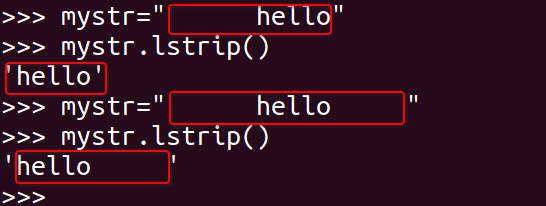
#### 13\. rstrip
刪除 mystr 字符串末尾的空白字符
~~~
mystr.rstrip()
~~~

#### 14\. strip
刪除mystr字符串兩端的空白字符
~~~
>>> a = "\n\t itcast \t\n"
>>> a.strip()
'itcast'
~~~
### 15\. rfind
類似于 find()函數,不過是從右邊開始查找.
~~~
mystr.rfind(str, start=0,end=len(mystr) )
~~~

### 16\. rindex
類似于 index(),不過是從右邊開始.
~~~
mystr.rindex( str, start=0,end=len(mystr))
~~~

### 17\. partition
把mystr以str分割成三部分,str前,str和str后
~~~
mystr.partition(str)
~~~

### 18\. rpartition
類似于 partition()函數,不過是從右邊開始.
~~~
mystr.rpartition(str)
~~~

### 19\. splitlines
按照行分隔,返回一個包含各行作為元素的列表
~~~
mystr.splitlines()
~~~
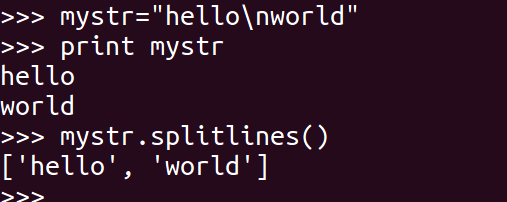
### 20\. isalpha
如果 mystr 所有字符都是字母 則返回 True,否則返回 False
~~~
mystr.isalpha()
~~~
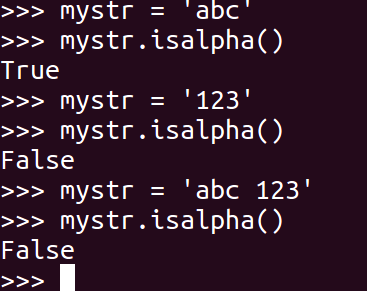
### 21\. isdigit
如果 mystr 只包含數字則返回 True 否則返回 False.
~~~
mystr.isdigit()
~~~

### 22\. isalnum
如果 mystr 所有字符都是字母或數字則返回 True,否則返回 False
~~~
mystr.isalnum()
~~~

### 23\. isspace
如果 mystr 中只包含空格,則返回 True,否則返回 False.
~~~
mystr.isspace()
~~~
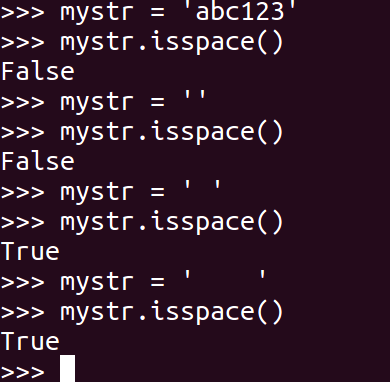
### 24\. join
mystr 中每個元素后面插入str,構造出一個新的字符串
~~~
mystr.join(str)
~~~
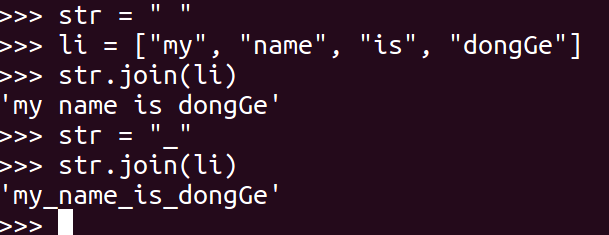
# 想一想
* (面試題)給定一個字符串aStr,返回使用空格或者'\\t'分割后的倒數第二個子串
](images/screenshot_1593859329967.png)
- 計算機組成原理和Python基礎知識
- 計算機組成原理
- 編程語言和Python
- 開發第一個Python程序
- 注釋
- 變量以及類型
- 標識符和關鍵字
- 輸出
- 輸入
- 運算符
- 數據類型轉換
- 判斷語句和循環語句
- 判斷語句介紹
- if語句
- 比較、關系運算符
- if...else...語句格式
- if...elif...else語句格式
- if語句的嵌套
- if應用:猜拳游戲
- 循環語句介紹
- while循環
- while循環應用
- while循環的嵌套以及應用
- for循環
- break和continue
- 字符串、列表、元組、字典
- 字符串介紹
- 字符串輸出
- 字符串輸入
- 下標和切片
- 字符串常見操作
- 列表介紹
- 列表的循環遍歷
- 列表的常見操作
- 列表的嵌套
- 元組
- 字典介紹
- 字典的常見操作1
- 字典的常見操作2
- 字典的遍歷
- 集合(擴展)
- 公共方法
- 4.函數(一)
- 4.1.函數介紹
- 4.2.函數定義和調用
- 4.3.函數的文檔說明
- 4.4.函數參數(一)
- 4.5.函數返回值(一)
- 4.6.函數的嵌套調用
- 4.7.函數應用:打印圖形和數學計算
- 5.函數(二)
- 5.1.局部變量
- 5.2.全局變量
- 5.3.多函數程序的基本使用流程
- 5.4.函數返回值(二)
- 5.5.函數參數(二)
- 5.6.拆包、交換變量的值
- 5.7.引用(一)
- 5.8.可變、不可變類型
- 5.9.引用(二)
- 5.10.函數使用注意事項
- 6.強化練習
- 6.1.函數應用:學生管理系統
- 6.2.遞歸函數
- 6.3. 匿名函數
- 6.4.列表推導式
- 6.5.set、list、tuple
- 6.6.高階函數: map reduce filter
- 7.文件操作,綜合應用
- 7.1.文件操作介紹
- 7.2.文件的讀寫
- 7.3.應用1:制作文件的備份
- 7.4.文件的相關操作
- 7.5.應用:批量修改文件名
- 7.6.綜合應用:學生管理系統(文件版)
- 8.面向對象(上)
- 8.1.認識面向對象編程
- 8.2.類和對象
- 8.3.定義類
- 8.4.創建對象
- 8.5.添加和獲取對象的屬性
- 8.6.在方法內通過self獲取對象屬性
- 8.7.魔法方法 - init()
- 8.8.魔法方法 - 有參數的__init__()方法
- 8.9.魔法方法 - str()方法
- 8.10.魔法方法 - del()方法
- 8.11.實操案例 - 烤土豆
- 9.面向對象(中)
- 9.1.實操案例 - 放家具
- 9.2.繼承的概念
- 9.3.單繼承
- 9.4.多繼承
- 9.5.子類重寫父類的同名屬性和方法
- 9.6.子類調用父類同名屬性和方法
- 9.7.多層繼承
- 9.8.通過super()來調用父類的方法
- 10.面向對象(下)
- 10.1.私有屬性和私有方法
- 10.2.修改私有屬性的值
- 10.3.多態
- 10.4.類屬性和實例屬性
- 10.5.靜態方法和類方法
- 11.異常處理與模塊初識
- 11.1.異常
- 11.2.捕獲異常
- 11.3.異常的傳遞
- 11.4.拋出自定義的異常
- 11.5.獲取異常完整信息的正確姿勢
- 11.6.認識模塊
- 11.7.開發模塊
- 11.8.模塊中的__all__(未完成)
- 11.9.python中的包(未完成)
- 12.課后加餐
- 12.1.基礎應用 - 進銷存管理系統(未完成)
- 12.2.基礎應用 - 員工信息管理系統(未完成)
- 12.1.編碼規范 - PEP8編碼規范(未完成)
